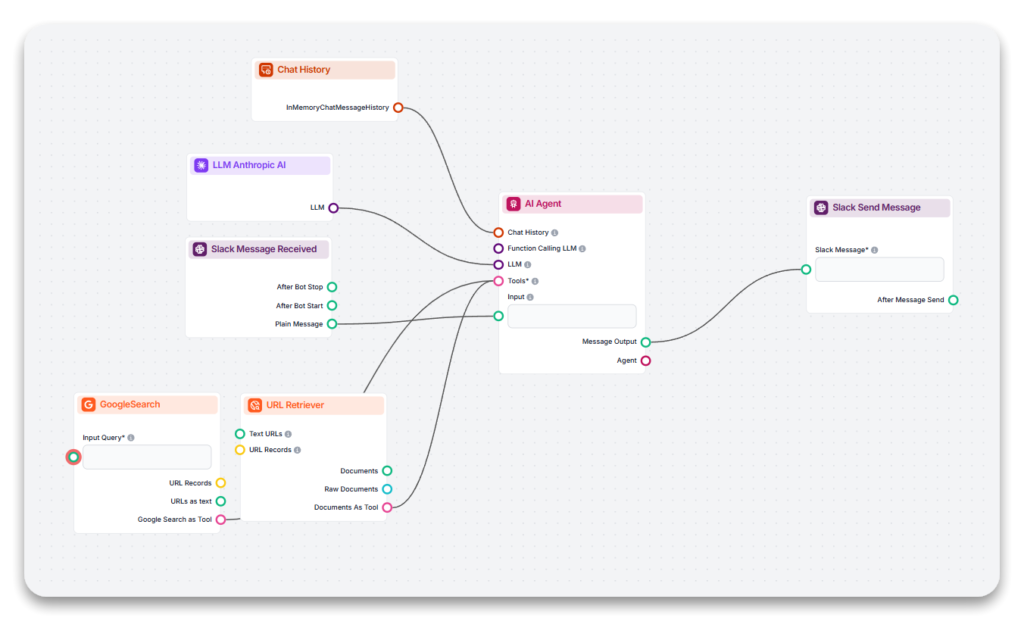Transform Slack with AI-Powered Slackbots Using Claude 3.5 Sonnet via Flowhunt
Imagine having a personal assistant seamlessly integrated into your Slack workspace—a bot that responds to questions, retrieves data, and performs tasks efficiently. With Claude 3.5 Sonnet powered by Flowhunt, this vision becomes a reality. From automating repetitive queries to streamlining workflows, this integration offers limitless possibilities to improve team collaboration and productivity.
Whether you’re just getting started with Slackbots or looking to elevate your Slack experience, this guide will walk you through the process. We’ll cover how to set up Slack integration in Flowhunt, create a simple AI-powered flow, and explore how this setup can revolutionize your team’s efficiency. By the end, your Slackbot will be ready to seamlessly support your team!
Setting Up the Slack Integration
Before creating your first flow, connect Flowhunt to Slack by following these steps:
- Access the Integrations Tab
Log in to your Flowhunt.io account and navigate to the Integrations tab on the dashboard. - Choose Slack
Select Slack from the available integrations to initiate the setu![]()
- Authorize Slack Access
You’ll be redirected to Slack’s login page. Enter your credentials and workspace URL. (Pro Tip: Your workspace URL is located in the top-left corner of your Slack app.)

- Grant Permissions
Approve the required permissions for Flowhunt, enabling the bot to read messages, respond, and interact within your Slack workspace.

With these steps complete, your Slack integration is active, and you’re ready to design your first Slackbot flow.
Building a Slackbot Flow
With the integration live, it’s time to create a Slackbot flow using Flowhunt’s intuitive no-code interface.

1. Add the “Slack Message Received” Component
This component acts as the starting point for your flow, listening for Slack messages and triggering actions.
- Configure the Channel and Workspace: Decide whether to monitor specific channels or the entire workspace. For better organization, consider creating a dedicated channel (e.g.,
#ai-assistant). - Enable “Only Trigger on Mention”: Ensure the bot responds only to direct mentions (e.g.,
@flowhunt) to prevent unnecessary replies.

2. Add the AI Agent Component
The AI Agent serves as the Slackbot’s brain, generating intelligent and relevant responses.
- Backstory: Define the bot’s role (e.g., “You are a resourceful and friendly Slack assistant”).
- Goal: Establish its primary objective, such as “Provide clear and accurate answers using all available tools.”

3. Incorporate Tools to Enhance the AI Agent
Boost your bot’s functionality with these tools:
- Google Search Tool: Perform real-time web searches to answer user queries accurately.
- URL Retriever: Extract and summarize information from links or documents shared in Slack.

Flowhunt also supports additional tools that can be customized to suit your team’s unique requirements.
4. Add the LLM Claude 3.5 Sonnet Component
Connect the LLM Claude 3.5 Sonnet component to harness its advanced language capabilities. Known for its nuanced understanding and precise responses, Claude 3.5 Sonnet delivers contextual and intelligent replies tailored to your team’s needs.

5. Add the “Slack Send Message” Component
This component handles sending the bot’s responses back to Slack, completing the interaction loop.
- Configure the Channel and Workspace: Align these settings with the ones configured in the “Slack Message Received” component.

6. Save and Test Your Flow
When your flow is ready:
- Save the configuration in Flowhunt.
- Open Slack and navigate to the designated channel.
- Mention the bot (e.g.,
@flowhunt) to test its functionality.
Congratulations! Your Slackbot, powered by Claude 3.5 Sonnet, is now equipped to handle tasks and queries efficiently.
Why Choose Flowhunt for Slackbots?
Flowhunt offers several key benefits for integrating Slackbots:
- Customizable: Adapt the bot’s features to suit your team’s unique needs, from answering FAQs to automating workflows.
- User-Friendly: The drag-and-drop interface makes it easy for non-technical users to design powerful workflows.
- Scalable: Expand the bot’s functionality as your team’s requirements grow.
- Increased Productivity: Automate routine tasks, allowing your team to focus on strategic initiatives.
Conclusion
Integrating Claude 3.5 Sonnet into Slack through Flowhunt unlocks the potential of AI for your workspace. With a simple setup and extensive customization options, your Slackbot can streamline communication, enhance productivity, and elevate your team’s efficiency.
Visit Flowhunt.io today to create your first Slackbot and revolutionize the way your team collaborates!
Adding Claude 2 to Slack for Your Team
Boost team productivity with Flowhunt's Claude 2 in Slack! Set up AI Slackbots effortlessly for seamless collaboration and task automation.
How Claude 3.5 Sonnet Operates as an AI Agent
Discover how Claude 3.5 Sonnet excels as an AI agent, enhancing automation and decision-making in various industries. Explore its capabilities!
Using Claude 3 Haiku with Slack for Smarter Teams
Integrate Claude 3 Haiku with Slack using Flowhunt to automate tasks, enhance team collaboration, and boost productivity effortlessly!





